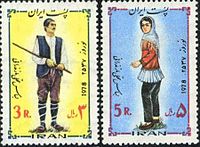- Mazandarani people
-
For additional information refer also to Persian peoples.
Mazandarani people Total population 3[1] to 4 million[2] (2006) Regions with significant populations Provinces of Mazandaran, Gilan, and Golestan in Iran Languages Religion Mostly Shi'a Muslim
Related ethnic groups Persian and other Iranian peoples, peoples of the Caucasus
The Mazandarani people are Iranian people [3][4][5] of Caucasus origin [6] living primarily in south of the Caspian Sea coast. The Elburz mountains mark the southern limit of Mazandarani peoples [7][8].
Contents
People
The population of Mazandarani people is between three[1] to four million (2006 estimation)[2]. The dominant religion among Mazandarani people is Shiite Islam.[9]
They are mainly living in south east of Caspian Sea coasts. Many of them live as farmers and fishermen [1]. They are highly related to other Iranian people in Iranian plateau[1][10]. In fact, rise of the new wave of Iranian nationalism in modern history of Iran is associated with inspiration of the Pahlavi dynasty, a Mazandarani origin dynasty. During this period this ideology was fostered by Pahlavis as well as reviving pre-Islamic Iranian traditions, Persian language reforms, etc.[11]
Language
The local Mazandarani, which belongs to Northwestern Iranian languages, is spoken among these people and most Mazandarani people are fluent in both Mazanadarni dialect and standard Persian.[7][9]. However, with the growth of education and press, the differentiation between Mazandarani and other Iranian dialects are likely to disappear.[7][9] Mazandarani is closely related to Gilaki and the two dialects [7] have similar vocabularies. These two dialects retain more than Persian does of the noun declension system that was characteristic of older-Iranian languages.[7]
Borjan states that Mazandarani has different sub-dialects and there exists a high mutual intelligibility among various Mazandarani sub-dialects.[9] Raymond Gordon in Ethnolue lists them as Gorgani, Palani, etc. However, he calls them dialects.[8]
Notable figures
Historic
- Abu Jafar Muhammad ibn Jarir ibn Yazid ibn Kathir al-Tabari (838–923), was a Mazandarani historian and theologian (the most famous and widely-influential person called al-Tabari).
- Abu Jafar Muhammad ibn Jarir ibn Rustom al-Tabari, was a Shia thinker who is commonly confused with the first one. He is the author of the book Dala'il al-Imamah (Proofs of the Imamate)
- Ali ibn Sahl Rabban al-Tabari, "Ali the scholar from Tabiristan" (838–870 A.D.) was the writer of a medical encyclopedia and the teacher of the scholar physician Zakariya al-Razi.
- Abul Hasan al-Tabari, a 10th century Iranian physician.
- Al-Tabarani, (c. 821–918 CE) the author of numerous ahadeeth.
- Amir Pazevari, poet.
- Maziar, Iranian aristocrat of the House of Karen.
Contemporary
- Reza Shah, Emperor of Iran (Persia) from 1924 to 1941
- Nima Yooshij (Poet)
- Emamali Habibi, (Olympic and World Champion / free style wrestling / Babreh Mazandaran)
- Ali Larijani, (a former member of the Supreme National Security Council of Iran and Speaker of the Majlis of Iran)
- Mohammad Javad Larijani, (a mathematician and former member of the Majlis)
- Sadegh Larijani, (Head of the judiciary of the Islamic Republic of Iran)
- Mohammad Zohari (Poet)
- Delkash (Singer)
- Gholam-Hossein Banan (Singer)
- Ehsan Tabari (marxist theoretician)
- Noureddin Kianouri (politician)
- Dr. Parviz Khanlari (writer/translator)
- Habibollah Badiei (musician)
- Reza Allamehzadeh (Director)
- Rashid Mostaghim (Singer)
Assimilated groups into the Mazandarani people
In the Safavid era Mazandaran was settled by Georgian migrants, whose descendants still live across Mazandaran [12]. Still many towns, villages and neighbourhoods in Mazandaran bear the name "Gorji" (i.e. Georgian) in them, although most of the Georgians are already assimilated into the mainstream Mazandaranis. The history of Georgian settlement is described by Eskandar Beyg Monshi, the author of the 17th century Tarikh-e Alam-Ara-ye Abbasi, in addition many foreigners e.g. Chardin, and Della Valle, have written about their encounters with the Georgian Mazandaranis.
See also
- Caspian people
- Māzandarān Province
- Mazandarani language
- List of famous people from Mazandaran
References
- ^ a b c d Middle East Patterns: Places, Peoples, and Politics By Colbert C. Held, John Cummings, Mildred McDonald Held,2005, page 119.
- ^ a b Iran Provinces
- ^ Area handbook for Iran By Harvey Henry Smith, American University (Washington, D.C.). Foreign Area Studies, American University (Washington, D.C.). Foreign Areas Studies, page 89
- ^ Academic American Encyclopedia By Grolier Incorporated, page 294
- ^ The World Book Encyclopedia By World Book, Inc, 2000, page 401
- ^ http://vetinarilord.blogspot.com/2006/05/where-west-meets-east-complex-mtdna.html
- ^ a b c d e Dalb, Andrew (1998). Dictionary of Languages: The Definitive Reference to More Than 400 Languages. Columbia University Press. p. 226. ISBN 0231115687.
- ^ a b Ethnologue report for language code:mzn
- ^ a b c d Bilingualism in Mazandaran: Peaceful Coexistence With Persian by Maryam Borjian, Columbia University, Page 66. Online Access: [1]
- ^ Iran, Encarta Encyclopedia Iran. Archived 2009-10-31.
- ^ Iranian nationalism and Reza Shah, MR Ghods – Middle Eastern Studies, 1991 – informaworld.com
- ^ ^ Muliani, S. (2001) Jaygah-e Gorjiha dar Tarikh va Farhang va Tammadon-e Iran. Esfahan: Yekta [The Georgians’ position in the Iranian history and civilization]
External links
Ethnic groups in Iran Major Minor Categories:- Mazandarani people
- Iranian peoples
- Ethnic groups in Iran
- Muslim communities
Wikimedia Foundation. 2010.



